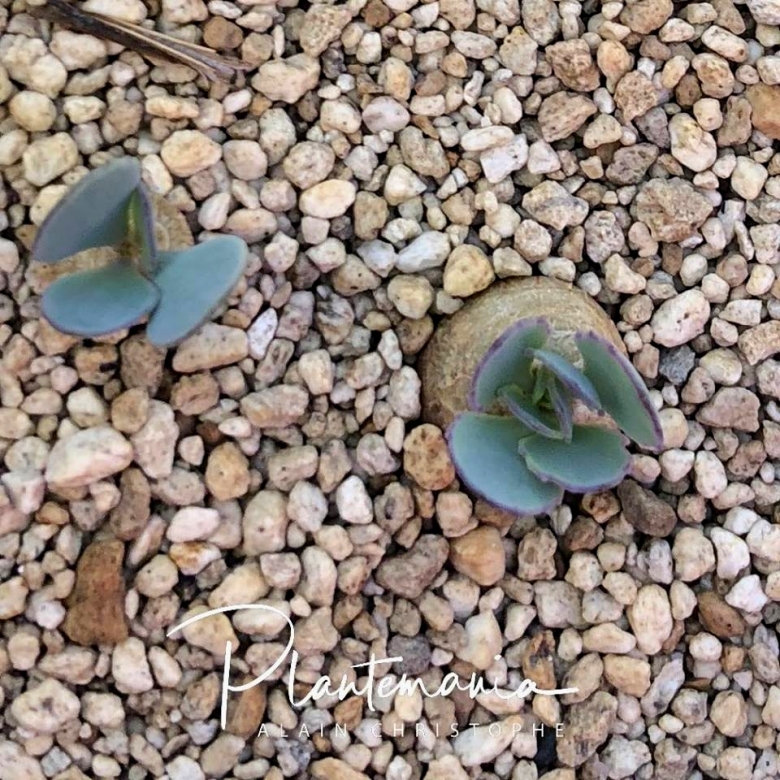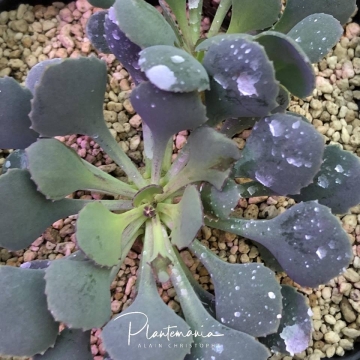
Othonna cacalioides.Two years old seedlings
Origin and Habitat: Northern Cape and Western Cape (Bokkeveld Escarpment to Gifberg), South Africa. Area of occurrence less than 20 km² and Southern Namibia.
Habitat and Ecology: Bokkeveld Sandstone Fynbos. This species occurs on cool and windswept levels and only in the shallowest rock pans (gritty soil) with a thin layer of coarse sand in quartzite pavement rocks of the Table Mountain Sandstone formation. O. cacalioides is potentially thereatened by habitat degradation, collection and trampling by livestock.
Synonyms:
See all synonyms of Othonna cacalioides
back
Accepted name in llifle Database:Othonna cacalioides L.f.Suppl. Pl. 388. 1782 [1781 publ. Apr 1782]Synonymy: 5
back
Common Names include:
ENGLISH: Tuberous Othonna, African Ragwort
Description: Othonna cacalioidesSN|35444]]SN|35441]] is a tiny, compact, glabrous, succulent, that may branch into as many as 20 or more short, stumpy heads, all scarcely above soil level, with a flattened, tuber-like stem, or caudex, below ground. After spring rain, small bright leaves are produced which die away in summer when their small yellow, daisy-like flowers are formed. In summer and autumn it shows only the bare fleshy stems. O. cacalioides is a member of the short caudiciform group and one that is likely to appear on the wanted list of many succulent plant collectors, this is one of the smallest of all succulents in the family Compositae.
Stem: Tuberous, flattened, potato-like, mostly below ground, broader than tall, to 9 cm in diameter or more, with a pale-brown or dull orangish, leathery, tough, glossy bark with white-woolly scars. Branches reduced to low hump, very thick, stumpy and fleshy to 2 cm in diameter.
Leaves: Tufted, obovate or spatulate, tapering at base into a narrow petiole, very obtuse, 2-2.5 cm long, 8-10 mm wide, thickish coriaceous, faintly 3-nerved, entire or minutely toothed, the margin thickened and subreflexed. The leaves are deciduous, and arise from a woolly tuft or sheathing base.
Inflorescence: Peduncle 2-8 cm long, twice as long as the leaves, one- to six-headed. Heads (capitula) small 5-7 mm in diameter, few-flowered. Involucre lobes (phyllaries) mostly 5, very broad. Ray florets5-8, yellow, limb recurved. Disc florets 12-30, yellow.
Fruits (achenes): Densely pubes-cent.
Remarks: Plants with single or little branched stems were previously known as Othonna pygmaeaSN|35441]]SN|35444]]. However the distinguishing characteristics of O. pygmaea, appear to fall within the natural variation of O. cacalioides and most authors have dismissed "pygmaea" as perhaps not worthy of even varietal status, but it still has a value for a collector because they identify plants with particular characters.
Bibliography: Major references and further lectures
1) Urs Eggli “Illustrated Handbook of Succulent Plants: Dicotyledons” Springer Science & Business Media, 2002
2) W. H. Harvey, “Flora Capensis”, Vol 3, 1894) Author: (By).
3) Goldblatt, P. and Manning, J.C. 2000. "Cape Plants: A conspectus of the Cape Flora of South Africa". Strelitzia 9. National Botanical Institute, Cape Town.
4) William Aiton, “Hortus Kewensis: Or, A Catalogue of the Plants Cultivated in the Royal Botanic Garden at Kew”, Volume 3, George Nicol, 1789
5) Veld & flora, Volume 2, page 56, Botanical Society of South Africa, 197
6) Hall, A.V., De Winter, M., De Winter, B. and Van Oosterhout, S.A.M. 1980. “Threatened plants of southern Africa”. South African National Scienctific Programmes Report 45. CSIR, Pretoria.
7) Hilton-Taylor, C. 1996. “Red data list of southern African plants”. Strelitzia 4. South African National Botanical Institute, Pretoria.
8) Raimondo, D., von Staden, L., Foden, W., Victor, J.E., Helme, N.A., Turner, R.C., Kamundi, D.A. and Manyama, P.A. 2009. “Red List of South African Plants”. Strelitzia 25. South African National Biodiversity Institute, Pretoria.
9) Victor, J.E. 2002. South Africa. In: J.S. Golding (ed), “Southern African plant Red Data Lists”. Southern African Botanical Diversity Network Report 14 (pp. 93-120), SABONET, Pretoria.
10) van Jaarsveld, E.J., Helme, N.A. & Raimondo, D. 2005. Othonna cacalioides L.f. National Assessment: Red List of South African Plants version 2017.1. Accessed on 2018/10/27
11) Keith Grantham, Paul Klaassen, “The plantfinder's guide to cacti & other succulents” Timber Press, 18 May 1999
 Othonna cacalioides. One year old seedling, the first flowering bud. Photo by: © Plantemania
Othonna cacalioides. One year old seedling, the first flowering bud. Photo by: © PlantemaniaSend a photo of this plant.The gallery now contains thousands of pictures, however it is possible to do even more. We are, of course, seeking photos of species not yet shown in the gallery but not only that, we are also looking for better pictures than those already present.
Read More... Cultivation and Propagation: Othonna cacalioidesSN|35441]]SN|35441]] is much sought-after by collectors, but one of the slowest and most difficult to grow in cultivation.











